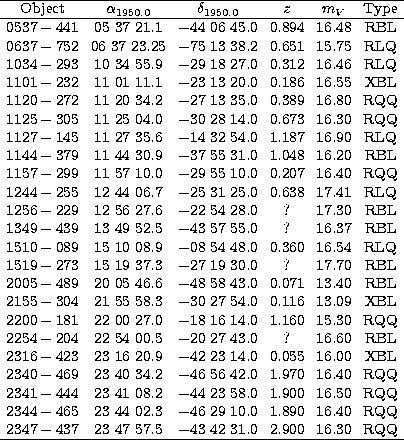 RLQ: radio-loud quasar, RQQ: radio-quiet quasar. |
The objects included in our program are listed in Table 1, along with their
1950.0 coordinates, redshifts, apparent visual magnitudes, and classification
of AGN-type.
 RLQ: radio-loud quasar, RQQ: radio-quiet quasar. |
Our observations were carried out during several observing runs in April,
July, September, and December 1997, and April 1998 with the 2.15-m
CASLEO telescope at San Juan, Argentina. This instrument was equipped
with a liquid-nitrogen-cooled CCD camera, using a Tek-1024 chip with
a read-out-noise of 9.6 electrons and a gain of 1.98 electrons/adu.
A focal-reducer provided a scale of 0.813 arcsec per pixel, and the
useful field of view was ![]() pix in diameter, or roughly
9 arcmin on the sky. Field frames were then sufficiently large as to contain at
least 6
non-variable stars of apparent magnitude similar to the AGN-target
magnitude. These stars were used during the data reduction procedure
for comparison and control purposes (see below).
pix in diameter, or roughly
9 arcmin on the sky. Field frames were then sufficiently large as to contain at
least 6
non-variable stars of apparent magnitude similar to the AGN-target
magnitude. These stars were used during the data reduction procedure
for comparison and control purposes (see below).
Microvariability observations were performed entirely using a Johnson's V filter with integration times between 30 and 500 s depending on the source brightness and the observing conditions. The signal-to-noise ratio at the central pixel of the AGN was fixed at a level such that the count rate was about 25% below the saturation limit in each case. A number of calibration frames (bias and flat-field images) were taken each night before the beginning of the observations. The variability monitoring of each AGN lasted at least 3 hours in order to make our results directly comparable to those obtained by Jang & Miller (1995, 1997) for northern objects. As in their campaigns, several AGNs were observed during more than one night.
The data reduction was made following standard procedures with the IRAF software package running on a UNIX workstation. All object images were debiased and flat-fielded using the normalized dome flat images. Magnitude measurements of the AGNs were made relatively to non-variable field stars using the aperture photometry routine APPHOT. Differential lightcurves for each pair of objects in the frame were constructed and used for detecting variable stars or any anomalous behaviour (e.g. saturated stars). Two groups of well-behaved stars of similar magnitude to the target were determined for each AGN (usually three stars per group), and then an average magnitude was computed for each group in each frame. In Fig. 1 we show a finding chart for the first AGN listed in Table 1, where the object and the selected stars are marked.
Copyright The European Southern Observatory (ESO)